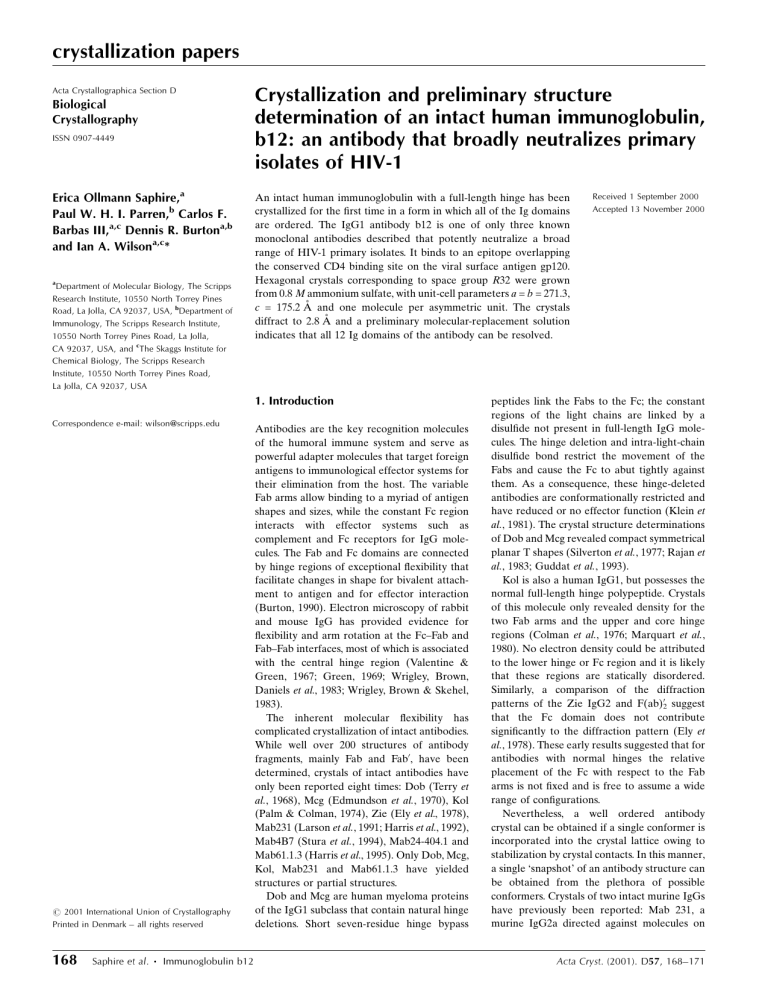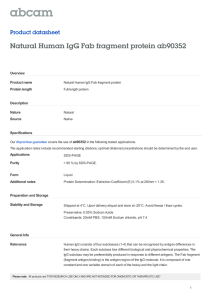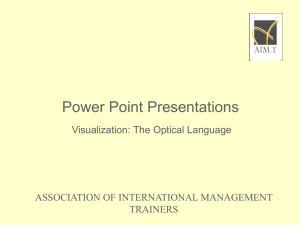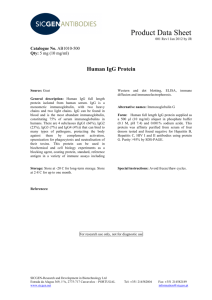crystallization papers Crystallization and preliminary structure determination of an intact human immunoglobulin,

crystallization papers
Acta Crystallographica Section D
Biological
Crystallography
ISSN 0907-4449
Erica Ollmann Saphire,
a
Paul W. H. I. Parren,
Barbas III,
a,c
and Ian A. Wilson
a,c
*
b
Carlos F.
Dennis R. Burton
a,b
Crystallization and preliminary structure determination of an intact human immunoglobulin, b12: an antibody that broadly neutralizes primary isolates of HIV-1
An intact human immunoglobulin with a full-length hinge has been crystallized for the ®rst time in a form in which all of the Ig domains are ordered. The IgG1 antibody b12 is one of only three known monoclonal antibodies described that potently neutralize a broad range of HIV-1 primary isolates. It binds to an epitope overlapping the conserved CD4 binding site on the viral surface antigen gp120.
Hexagonal crystals corresponding to space group R 32 were grown from 0.8
M ammonium sulfate, with unit-cell parameters a = b = 271.3, c = 175.2 AÊ and one molecule per asymmetric unit. The crystals diffract to 2.8 AÊ and a preliminary molecular-replacement solution indicates that all 12 Ig domains of the antibody can be resolved.
Received 1 September 2000
Accepted 13 November 2000 a Department of Molecular Biology, The Scripps
Research Institute, 10550 North Torrey Pines
Road, La Jolla, CA 92037, USA, b Department of
Immunology, The Scripps Research Institute,
10550 North Torrey Pines Road, La Jolla,
CA 92037, USA, and c The Skaggs Institute for
Chemical Biology, The Scripps Research
Institute, 10550 North Torrey Pines Road,
La Jolla, CA 92037, USA
Correspondence e-mail: wilson@scripps.edu
# 2001 International Union of Crystallography
Printed in Denmark ± all rights reserved
168
Saphire et al.
Immunoglobulin b12
1. Introduction
Antibodies are the key recognition molecules of the humoral immune system and serve as powerful adapter molecules that target foreign antigens to immunological effector systems for their elimination from the host. The variable
Fab arms allow binding to a myriad of antigen shapes and sizes, while the constant Fc region interacts with effector systems such as complement and Fc receptors for IgG molecules. The Fab and Fc domains are connected by hinge regions of exceptional ¯exibility that facilitate changes in shape for bivalent attachment to antigen and for effector interaction
(Burton, 1990). Electron microscopy of rabbit and mouse IgG has provided evidence for
¯exibility and arm rotation at the Fc±Fab and
Fab±Fab interfaces, most of which is associated with the central hinge region (Valentine &
Green, 1967; Green, 1969; Wrigley, Brown,
Daniels et al.
, 1983; Wrigley, Brown & Skehel,
1983).
The inherent molecular ¯exibility has complicated crystallization of intact antibodies.
While well over 200 structures of antibody fragments, mainly Fab and Fab 0 , have been determined, crystals of intact antibodies have only been reported eight times: Dob (Terry et al.
, 1968), Mcg (Edmundson et al.
, 1970), Kol
(Palm & Colman, 1974), Zie (Ely et al.
, 1978),
Mab231 (Larson et al.
, 1991; Harris et al.
, 1992),
Mab4B7 (Stura et al.
, 1994), Mab24-404.1 and
Mab61.1.3 (Harris et al.
, 1995). Only Dob, Mcg,
Kol, Mab231 and Mab61.1.3 have yielded structures or partial structures.
Dob and Mcg are human myeloma proteins of the IgG1 subclass that contain natural hinge deletions. Short seven-residue hinge bypass peptides link the Fabs to the Fc; the constant regions of the light chains are linked by a disul®de not present in full-length IgG molecules. The hinge deletion and intra-light-chain disul®de bond restrict the movement of the
Fabs and cause the Fc to abut tightly against them. As a consequence, these hinge-deleted antibodies are conformationally restricted and have reduced or no effector function (Klein et al.
, 1981). The crystal structure determinations of Dob and Mcg revealed compact symmetrical planar T shapes (Silverton et al.
, 1977; Rajan et al.
, 1983; Guddat et al.
, 1993).
Kol is also a human IgG1, but possesses the normal full-length hinge polypeptide. Crystals of this molecule only revealed density for the two Fab arms and the upper and core hinge regions (Colman et al.
, 1976; Marquart et al.
,
1980). No electron density could be attributed to the lower hinge or Fc region and it is likely that these regions are statically disordered.
Similarly, a comparison of the diffraction
0
2 patterns of the Zie IgG2 and F(ab) suggest that the Fc domain does not contribute signi®cantly to the diffraction pattern (Ely et al.
, 1978). These early results suggested that for antibodies with normal hinges the relative placement of the Fc with respect to the Fab arms is not ®xed and is free to assume a wide range of con®gurations.
Nevertheless, a well ordered antibody crystal can be obtained if a single conformer is incorporated into the crystal lattice owing to stabilization by crystal contacts. In this manner, a single `snapshot' of an antibody structure can be obtained from the plethora of possible conformers. Crystals of two intact murine IgGs have previously been reported: Mab 231, a murine IgG2a directed against molecules on
Acta Cryst.
(2001). D 57 , 168±171
the surface of canine lymphoma cells
(Larson et al.
, 1991; Harris et al.
, 1992), and
Mab 61.1.3, a murine IgG1 directed against the small molecule phenobarbital (Harris et al.
, 1995, 1998). Their structures are both highly asymmetric and exhibit strikingly different conformations as a consequence of speci®c Fab±Fab and Fab±Fc contacts within the crystal lattice. Mab 231 displays a distorted T shape (172 between the long axes of the Fabs) and Mab 61.1.3 a distorted
Y shape (115 between the Fabs). In both structures, the Fc domain is obliquely disposed relative to that of the Fabs (128 and 107 , respectively). These intact antibodies crystallize in the space groups P 1 and
P 2
1
, respectively, with one IgG per asymmetric unit. Thus, although the IgG is composed of two identical light and heavy chains, their conformers in the crystal are suf®ciently asymmetric that at least one whole IgG molecule must comprise any asymmetric unit. On the other hand, the hinge-deleted Dob and Mcg, as well as the intact Kol in which the Fc is disordered, each crystallize with one-half of a molecule (one light chain and one heavy chain) in the asymmetric unit.
Here, we present the crystallization and preliminary structure analysis of b12, a human IgG1 antibody that is a broad and potent neutralizer of HIV-1. This antibody was selected by phage-display technology from a bone-marrow library from a longterm asymptomatic HIV-1 infected male
(Burton et al.
, 1991) and is directed against a highly conserved epitope overlapping the
CD4 binding site on the viral surface protein gp120. IgG1 b12 neutralizes a wide range of primary isolates of HIV-1 of different clades
(Burton et al.
, 1994; Trkola et al.
, 1995;
Kessler et al.
, 1997; D'Souza et al.
, 1997).
Antibody b12 can bind to monomeric gp120 in solution or to oligomeric gp120 on the viral surface (Parren, Mondor et al.
, 1998)
Figure 1
Crystals of the intact IgG1 b12.
Acta Cryst.
(2001). D 57 , 168±171 and protects against infection with HIV-1 primary isolates in passive immunization experiments (Gauduin et al.
, 1997). As this antibody is one of only three currently identi®ed monoclonal antibodies that have this key combination of ef®cacy and broad speci®city (D'Souza et al.
, 1997), it may serve as a valuable template for HIV-1 vaccine design.
2. Methods and results
2.1. Protein purification
The Fab fragment of b12 was originally identi®ed from a phage-display library
(Burton et al.
, 1991) and was converted into an entire IgG1 molecule for viral neutralization studies as described previously
(Burton et al.
, 1994). Recombinant IgG1 was expressed in Chinese hamster ovary
(CHO-K1) cells in GMEM media containing
10% fetal calf serum (FCS). Standard protocols suggested weaning CHO cells from initial cultures in 10% FCS to 0.5%
FCS before induction of human IgG expression in order to limit contamination with bovine IgG. However, numerous attempts to crystallize antibody (both whole
IgG and its Fab cleavage product) produced in media containing 0.5% FCS were unsuccessful, as were attempts to crystallize recombinant Fab and scFv produced in
Escherichia coli . However, higher FCS levels appear to foster increased cell and protein stability, as samples produced in 10% FCS were the only material that crystallized and protein yields in 10% FCS (20±33 mg l ÿ 1 ) were at least 20-fold higher than those from identical cells weaned to 0.5% FCS
(1 mg l ÿ 1 ).
IgG is secreted into cell media and recovered using Protein A af®nity chromatography followed by elution in 0.1
M citric acid, pH 3.0. Fractions were neutralized by
2 M Tris base pH 9.0 and dialysed against phosphate-buffered saline (PBS) pH 7.0.
The resulting human immunoglobulin purity is greater than 99.6%, with less than 0.4% contaminating bovine IgG. All batches were tested for gp120 binding by ELISA and viral neutralization, as described by Parren, Wang et al.
(1998). Existence of two full-length biantennary oligosaccharide chains on the
Fc region was con®rmed by hydrazine release and reacetylation using a GlycoPrep
1000 (Oxford Glycosciences, Abingdon,
UK), 2-aminobenzamide labeling (Bigge et al.
, 1995) and HPLC phase separation on a
Glycosep-N chromatography column
(Glyko Biomedical Ltd, Novato, CA, USA) at the Oxford Glycobiology Institute.
crystallization papers
Carbohydrate structures were assigned according to Guile et al.
(1996).
2.2. Crystallization
Initial crystallization conditions were identi®ed with IgG at 16 mg ml ÿ 1 in PBS pH
7.2 plus 0.02% sodium azide. A simple footprint screen (Stura et al.
, 1992) produced small crystals in 3±7 d in 1 M ammonium sulfate, pH 5.5, by sitting-drop vapor diffusion. A decrease in ammonium sulfate concentration and a change in buffer to sodium cacodylate produced large crystals suitable for X-ray diffraction studies in
4±8 d. The b12 crystals reach full size (0.6
0.4
0.4 mm) after 2±4 d of growth and exhibit trapezoidal and pyramidal morphologies (Fig. 1). Final crystallization conditions are 800 m M ammonium sulfate, 100 m M sodium cacodylate, pH 6.5.
The successful use of a low-salt PEG 3350 and detergent screen (Harris et al.
, 1995) was reported for the crystallization of three out of ®ve intact murine monoclonal antibodies produced in hybridoma cell lines. However, the initial step in this crystallization procedure involves dialysis against ddH
2
O for
24 h. That method was unsuitable for this study as IgG1 b12 is a euglobulin and is insoluble in plain water. Although Mcg, another euglobulin, crystallizes upon dialysis into low-salt solutions (Edmundson et al.
, 1970), b12 irreversibly precipitates under these conditions. Kol and b12 both crystallize in ammonium sulfate (Kol in
1.5
M ). Thus, low-salt screens may not be applicable to all IgGs.
2.3. Data collection and processing
Data were initially collected to 4 AÊ resolution at room temperature on a MAR
Research imaging plate mounted on a
Siemens rotating-anode generator in the laboratory (Siemens Inc., Madison, WI,
USA) and on a Rigaku high-brilliance rotating-anode generator at University of
California, San Diego (Rigaku Inc., The
Woodlands, TX, USA). Subsequently, data were collected from single cryocooled crystals to 3.0 AÊ at beamline 5-2 of the
Advanced Light Source (ALS) and to 2.8 AÊ resolution on beamline 7-1 at the Stanford
Synchrotron Radiation Laboratory (SSRL).
Crystals were mounted in loops (Hampton
Research), dipped into mother liquor containing either 25% glycerol or 22.5±25% ethylene glycol as cryoprotectant and ¯ashcooled in liquid N
2
. A 2.8 AÊ data set was collected at 96 K on a MAR Research imaging plate with a crystal-to-detector distance of 350 mm. Processing and scaling
Saphire et al.
Immunoglobulin b12
169
crystallization papers
Table 1
Crystallographic parameters and data-collection statistics.
Values in parentheses refer to the last resolution shell.
Space group
Unit-cell parameters (AÊ)
Packing density V
M
Solvent content (%)
Resolution (AÊ)
(AÊ 3
Total observations
Unique re¯ections
Redundancy
Average I / ( I )
R sym
( I ) (%)
Completeness (%)
Da ÿ 1 )
R a
32
= b = 271.3, c = 175.2
4.11
69.8
30±2.8 (2.85±2.80)
170537 (8680)
57121 (3179)
3.0 (2.7)
18.8 (2.4)
7.2 (51.3)
94.4 (95.3) of the data were performed using the programs DENZO (Otwinowski, 1993) and
SCALEPACK (Otwinowski & Minor, 1997) with an overall R merge of 7.2% (see Table 1 for additional data statistics).
Crystals can be assigned to the space group R 32 and were indexed in the triply primitive hexagonal unit cell with unit-cell parameters a = b = 271.3, c = 175.2 AÊ. As the
Matthews coef®cient of 4.11 AÊ 3 Da ÿ 1 and the corresponding 70% solvent content are fairly high, it was possible that two IgGs constituted the asymmetric unit ( V
M of 2.05
and solvent content of 40%). The structure determination of IgG1 b12 proceeded by multi-body molecular replacement using
AMoRe (Navaza, 1994) and individual Fab and Fc domains as search models. Although a molecular-replacement solution for an Fc domain was immediately clear, those of the
Fabs were more elusive and nearly 100 search models had to be tested before solutions could be found. Very frequently, search models that produced one or two outstanding peaks in rotation functions yielded no solutions in translation functions.
In fact, the combination of search model and rotation angles that ultimately succeeded in producing a clear translation solution for each of the Fabs yielded no clear solution in the rotation function. It seemed possible that an additional three solutions could be similarly masked in noise and it was not immediately apparent that the three identi-
®ed solutions would be able to form a single
IgG, given the arrangement and separation induced by the extreme asymmetry of the actual structure.
SDS gel electrophoresis of the crystals demonstrated that the hinge was indeed intact. Thus, the hinge region accounts for an additional 22 residues between the Fab and
Fc search models, representing a maximal connecting distance of approximately 75 AÊ, if fully extended. Coordinates were calculated for one of the 18 Fcs in the unit cell and
170
Saphire et al.
Immunoglobulin b12 then for each of the 18 copies of the ®rst Fab solution, followed by each of the 18 copies of the second Fab solution. Only one combination of two Fabs and one Fc yielded distances of less than 75 AÊ from the
C-terminus of the Fab heavy-chain globular domain to the N-terminus of the Fc model
(34 AÊ for one Fab and 44 AÊ for the other).
Thus, in the structure determination, only one 151 kDa IgG molecule is found in the asymmetric unit, with a Matthews coef®cient
V Da ÿ 1 and a
M
(Matthews, 1968) of 4.11 AÊ solvent content of 69.8%.
3
The R value after molecular replacement was 0.48 and R and R free cryst after rigid-body re®nement were 0.45 and 0.47, respectively.
The successful search model used for the two Fab domains displays a mere 52% sequence identity to b12 (PDB entry 1cbv;
Herron et al.
, 1991). Upon correction of the model sequence to the b12 sequence, R cryst and R free were reduced to 0.37 and 0.44, respectively. Model building and re®nement are in progress to 2.8 AÊ resolution.
However, visual inspection of the initial maps has already revealed interpretable electron density for all Ig domains and the carbohydrate. Density for the ¯exible hinge region is being improved through density modi®cation and phase weighting and recombination.
This work was supported by NIH Grants
RO1 GM46192 (IAW), AI40377 (PWHIP),
AI33292 (DRB) and AI37470 (CFB). We thank Dr Peter Kuhn of SSRL, Dr Thomas
Earnest of ALS, Dr Xuong Nguyen-Huu of
UCSD and Drs Robyn Stan®eld and
Xiaoping Dai of TSRI for assistance in data collection and processing, Ann Hessell of
TSRI for protein expression and puri®cation and Dr Pauline Rudd and Professor
Raymond Dwek of Oxford Glycobiology
Institute, Oxford University for carbohydrate sequencing and analysis. This is publication No. 13524-MB from The Scripps
Research Institute.
References
Bigge, J. C., Patel, T. P., Bruce, J. A., Goulding,
P. N., Charles, S. M. & Parekh, R. B. (1995).
Anal. Biochem.
230 , 229±238.
Burton, D. R. (1990).
Fc Receptors and the Action of Antibodies , edited by H. Metzger, pp. 31±54.
Washington, DC: American Society of Microbiology.
Burton, D. R., Barbas, C. F. III, Persson, M. A.,
Koenig, S., Chanock, R. M. & Lerner, R. A.
(1991).
Proc. Natl Acad. Sci. USA , 88 , 10134±
10137.
Burton, D. R., Pyati, J., Koduri, R., Sharp, S. J.,
Thornton, G. B., Parren, P. W. H. I., Sawyer,
L. S. W., Hendry, R. M., Dunlop, N., Nara, P. L.,
Lamaccchia, M., Garratty, E., Stiehm, E. R.,
Bryson, Y. J., Cao, Y., Moore, J. P., Ho, D. D. &
Barbas, C. F. III (1994).
Science , 266 , 1024±
1027.
Colman, P. M., Deisenhofer, J., Huber, R. & Palm,
W. (1976).
J. Mol. Biol.
100 , 257±278.
D'Souza, M. P., Livnat, D., Bradac, J. A. & Bridges,
S. H. (1997).
J. Infect. Dis.
175 , 1056±1062.
Edmundson, A. B., Wood, M. K., Schiffer, M.,
Hardman, K. D., Ainsworth, C. F., Ely, K. R. &
Deutsch, H. F. (1970).
J. Biol. Chem.
245 , 2763±
2764.
Ely, K. R., Colman, P. M., Abola, E. E., Hess, A. C.,
Peabody, D. S., Parr, D. M., Connell, G. E.,
Laschinger, C. A. & Edmundson, A. B. (1978).
Biochemistry , 17 , 820±823.
Gauduin, M. C., Parren, P. W. H. I., Weir, R.,
Barbas, C. F. III, Burton, D. R. & Koup, R. A.
(1997).
Nature Med.
3 , 1389±1393.
Green, N. M. (1969).
Adv. Immunol.
11 , 1±30.
Guddat, L. W., Herron, J. N. & Edmundson, A. B.
(1993).
Proc. Natl Acad. Sci. USA , 90 , 4271±
4275.
Guile, G. R., Rudd, P. M., Wing, D. R., Prime, S. B.
& Dwek, R. A. (1996).
Anal. Biochem.
240 ,
210±226.
Harris, L. J., Larson, S. B., Hasel, K. W., Day, J.,
Greenwood, A. & McPherson, A. (1992).
Nature (London) , 360 , 369±372.
Harris, L. J., Skaletsky, E. & McPherson, A.
(1995).
Proteins , 23 , 285±289.
Harris, L. J., Skaletsky, E. & McPherson, A.
(1998).
J. Mol. Biol.
275 , 861±872.
Herron, J. N., He, X. M., Ballard, D. W., Blier, P. R.,
Pace, P. E., Bothwell, A. L., Voss, E. W. Jr &
Edmundson, A. B. (1991).
Proteins , 11 , 159±175.
Kessler, J. A. II, McKenna, P. M., Emini, E. A.,
Chan, C. P., Patel, M. D., Gupta, S. K., Mark,
G. E. III, Barbas, C. F. III, Burton, D. R. &
Conley, A. J. (1997).
AIDS Res. Hum. Retrovir.
13 , 575±582.
Klein, M., Haeffner-Cavaillon, N., Isenman, D. E.,
Rivat, C., Navia, M. A., Davies, D. R. &
Dorrington, K. J. (1981).
Proc. Natl Acad. Sci.
USA , 78 , 524±8.
Larson, S., Day, J., Greenwood, A., Skaletsky, E. &
McPherson, A. (1991).
J. Mol. Biol.
222 , 17±19.
Marquart, M., Deisenhofer, J., Huber, R. & Palm,
W. (1980).
J. Mol. Biol.
141 , 369±391.
Matthews, B. W. (1968).
J. Mol. Biol.
33 , 491±
497.
Navaza, J. (1994).
Acta Cryst.
A 50 , 157±163.
Otwinowski, Z. (1993).
Proceedings of the CCP4
Study Weekend. Data Collection and Processing , edited by L. Sawyer, N. Isaacs & S. Bailey, pp. 56±62. Warrington: Daresbury Laboratory.
Otwinowski, Z. & Minor, W. (1997).
Methods
Enzymol.
276 , 307±326.
Palm, W. & Colman, P. M. (1974).
J. Mol. Biol.
82 ,
587±588.
Parren, P. W. H. I., Mondor, I., Naniche, D., Ditzel,
H. J., Klasse, P. J., Burton, D. R. & Sattentau,
Q. J. (1998).
J. Virol.
72 , 3512±3519.
Parren, P. W. H. I., Wang, M., Trkola, A., Binley,
J. M., Purtscher, M., Katinger, H., Moore, J. P. &
Burton, D. R. (1998).
J. Virol.
72 , 10270±10274.
Rajan, S. S., Ely, K. R., Abola, E. E., Wood, M. K.,
Colman, P. M., Athay, R. J. & Edmundson, A. B.
(1983).
Mol. Immunol.
20 , 787±799.
Silverton, E. W., Navia, M. A. & Davies, D. R.
(1977).
Proc. Natl Acad. Sci. USA , 74 , 5140±
5144.
Acta Cryst.
(2001). D 57 , 168±171
Stura, E. A., Nemerow, G. R. & Wilson, I. A.
(1992).
J. Cryst. Growth , 122 , 273±285.
Stura, E. A., Satterthwait, A. C., Calvo, J. C.,
Stefanko, R. S., Langeveld, J. P. & Kaslow, D. C.
(1994).
Acta Cryst.
D 50 , 556±562.
Terry, W. D., Matthews, B. W. & Davies, D. R.
(1968).
Nature (London) , 220 , 239±241.
Trkola, A., Pomales, A. B., Yuan, H., Korber, B.,
Maddon, P. J., Allaway, G. P., Katinger, H.,
Barbas, C. F. III, Burton, D. R., Ho, D. D. &
Moore, J. P. (1995).
J. Virol.
69 , 6609±6617.
Valentine, R. C. & Green, N. M. (1967).
J. Mol.
crystallization papers
Biol.
27 , 615±617.
Wrigley, N. G., Brown, E. B., Daniels, R. S.,
Douglas, A. R., Skehel, J. J. & Wiley, D. C.
(1983).
Virology , 131 , 308±314.
Wrigley, N. G., Brown, E. B. & Skehel, J. J. (1983).
J. Mol. Biol.
169 , 771±774.
Acta Cryst.
(2001). D 57 , 168±171 Saphire et al.
Immunoglobulin b12
171



